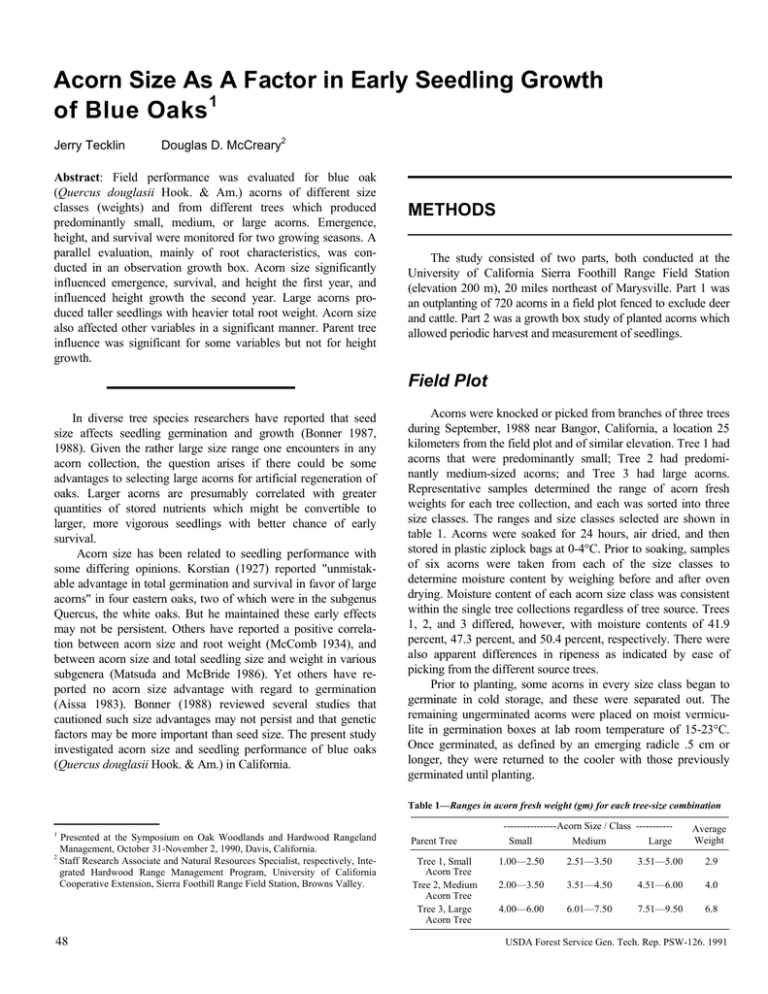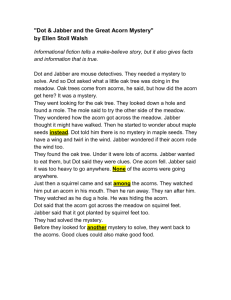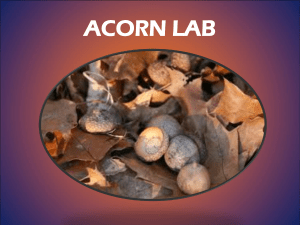Acorn Size As A Factor in Early Seedling Growth METHODS 1
advertisement

Acorn Size As A Factor in Early Seedling Growth of Blue Oaks 1 Jerry Tecklin Douglas D. McCreary2 Abstract: Field performance was evaluated for blue oak (Quercus douglasii Hook. & Am.) acorns of different size classes (weights) and from different trees which produced predominantly small, medium, or large acorns. Emergence, height, and survival were monitored for two growing seasons. A parallel evaluation, mainly of root characteristics, was con­ ducted in an observation growth box. Acorn size significantly influenced emergence, survival, and height the first year, and influenced height growth the second year. Large acorns pro­ duced taller seedlings with heavier total root weight. Acorn size also affected other variables in a significant manner. Parent tree influence was significant for some variables but not for height growth. METHODS The study consisted of two parts, both conducted at the University of California Sierra Foothill Range Field Station (elevation 200 m), 20 miles northeast of Marysville. Part 1 was an outplanting of 720 acorns in a field plot fenced to exclude deer and cattle. Part 2 was a growth box study of planted acorns which allowed periodic harvest and measurement of seedlings. Field Plot In diverse tree species researchers have reported that seed size affects seedling germination and growth (Bonner 1987, 1988). Given the rather large size range one encounters in any acorn collection, the question arises if there could be some advantages to selecting large acorns for artificial regeneration of oaks. Larger acorns are presumably correlated with greater quantities of stored nutrients which might be convertible to larger, more vigorous seedlings with better chance of early survival. Acorn size has been related to seedling performance with some differing opinions. Korstian (1927) reported "unmistak­ able advantage in total germination and survival in favor of large acorns" in four eastern oaks, two of which were in the subgenus Quercus, the white oaks. But he maintained these early effects may not be persistent. Others have reported a positive correla­ tion between acorn size and root weight (McComb 1934), and between acorn size and total seedling size and weight in various subgenera (Matsuda and McBride 1986). Yet others have reported no acorn size advantage with regard to germination (Aissa 1983). Bonner (1988) reviewed several studies that cautioned such size advantages may not persist and that genetic factors may be more important than seed size. The present study investigated acorn size and seedling performance of blue oaks (Quercus douglasii Hook. & Am.) in California. Acorns were knocked or picked from branches of three trees during September, 1988 near Bangor, California, a location 25 kilometers from the field plot and of similar elevation. Tree 1 had acorns that were predominantly small; Tree 2 had predomi­ nantly medium-sized acorns; and Tree 3 had large acorns. Representative samples determined the range of acorn fresh weights for each tree collection, and each was sorted into three size classes. The ranges and size classes selected are shown in table 1. Acorns were soaked for 24 hours, air dried, and then stored in plastic ziplock bags at 0-4°C. Prior to soaking, samples of six acorns were taken from each of the size classes to determine moisture content by weighing before and after oven drying. Moisture content of each acorn size class was consistent within the single tree collections regardless of tree source. Trees 1, 2, and 3 differed, however, with moisture contents of 41.9 percent, 47.3 percent, and 50.4 percent, respectively. There were also apparent differences in ripeness as indicated by ease of picking from the different source trees. Prior to planting, some acorns in every size class began to germinate in cold storage, and these were separated out. The remaining ungerminated acorns were placed on moist vermicu­ lite in germination boxes at lab room temperature of 15-23°C. Once germinated, as defined by an emerging radicle .5 cm or longer, they were returned to the cooler with those previously germinated until planting. Table 1—Ranges in acorn fresh weight (gm) for each tree-size combination 1 Presented at the Symposium on Oak Woodlands and Hardwood Rangeland Management, October 31-November 2, 1990, Davis, California. 2 Staff Research Associate and Natural Resources Specialist, respectively, Inte­ grated Hardwood Range Management Program, University of California Cooperative Extension, Sierra Foothill Range Field Station, Browns Valley. 48 ----------------Acorn Size / Class ----------Parent Tree Tree 1, Small Acorn Tree Tree 2, Medium Acorn Tree Tree 3, Large Acorn Tree Small Medium Large Average Weight 1.00—2.50 2.51—3.50 3.51—5.00 2.9 2.00—3.50 3.51—4.50 4.51—6.00 4.0 4.00—6.00 6.01—7.50 7.51—9.50 6.8 USDA Forest Service Gen. Tech. Rep. PSW-126. 1991 The field plot was on a northeast facing 15 percent slope, in Sobrante-Las Posas, very rocky loam. Competing vegetation had been glyphosate treated in early fall and the dead plant cover and top few centimeters of soil carefully scalped off by tractor blade. A uniform planting area was thus created, with 720 planting spots arranged in eight blocks of nine rows each, a randomized complete block design. Each row had 10 planting spots on 30-cm centers; the rows were 60 cm apart. Rows were randomly assigned to acorns from the nine different tree sourceacorn size classes. Acorns were planted over a 3 week period beginning December 20, 1988. All but 80 acorns were planted in the first week; 40 from Tree 1 and 40 from Tree 3 were slower to germinate in the germination boxes and were planted two weeks later than the rest. All were planted on their sides at 2-3 cm depth with radicles pointing in natural downward position. Only acorns with radicles less than 2 cm were planted. Beginning in March and continuing throughout the summer the plot was evaluated twice weekly for seedling emergence, which was defined as first visible sign of the shoot. The plot was hand weeded on occasion, but competing vegetation was very slow to return. No irrigation was provided. Year-end survival and height measurements were taken, and the plot was similarly monitored the following year. Growth Box A selection of acorns from Tree 2, the medium sized acorn tree, was reserved for planting in two plywood growth boxes. Each box measured 50 cm by 90 cm by 100 cm deep. The boxes were each partitioned into ten compartments 8 cm wide using polyethylene covered sliding partitions. Each compartment was filled with soil from the field plot site, sifted through a 1.3 cm screen, and compacted by thoroughly watering to promote settling. The planting design was a split plot, so that each removable compartment contained four replications of ran­ domly assigned small, medium, or large pre-germinated acorns. All acorns were planted on December 19, 1988, with points up and then covered with 2-3 cm soil. This planting position was necessary to fit in all the acorns, with 2-3 cm spaces between them. It differed from the on-side position of our field plantings. Extra acorns were planted on outside planting spots to serve as buffers and were not included in the data. The outermost compartments, which corresponded to the first and last harvest dates, were also considered buffers. The boxes were kept outdoors except for a brief period (two nights) of sub-freezing temperatures when they were moved to an unheated warehouse. It was possible to harvest the acorns in each compartment by removing the entire compartment and either carefully excavat­ ing the acorn and its root system (early stages only), or gently removing all soil with a fine water spray. Roots were thus recovered in very clean condition, nearly 100 percent intact. We measured and calculated acorn fresh weight prior to planting, dry weight at harvest to fresh weight ratio (an index of nutrient depletion), total length of root system, number of branched roots vs. tap root configuration, dry weight of root in 20 cm segments, numbers of laterals emanating from the first segment, length of USDA Forest Service Gen. Tech. Rep. PSW-126. 1991 longest lateral, length and weight of shoot, and date of shoot emergence. The first compartment was harvested one month after planting. So little growth had occurred that the next harvest occurred one month later on February 21, 1989, and every two weeks thereafter until June 13. Data were analyzed by ANOVA and, when significant differences (P≤5.05) were detected, by a Fisher's Protected LSD test. Harvest dates were treated as random variables, but by necessity the compartments had to be harvested in a serial, nonrandom fashion. We believe this not to have been a serious violation of the design since the differences measured between harvest dates were in all cases very great. RESULTS Field Trial In the field, the timing of acorn emergence was unusual. Generally, the emergence pattern was not typical of our experi­ ence for this site. The main emergence period was April 1- June 1(fig. 1). Fast germinating species like blue oak typically show emergence curves considerably steeper in slope and much earlier in the year after late fall planting (McCreary 1990). Furthermore, the 64 percent emergence for the first year was somewhat low, although not unusually low from the experience of others for this site. Unusual weather patterns could account for these results. We would have expected greatest emergence during February - March. During these two months, the Field Station recorded minimum temperatures for several days as low as -10 and -5°C; and February's mean low was 1.7°C, compared to the 20 year norm of 5°C. Precipitation in March 1989 was in excess of 30 cm, compared to the norm of 9 cm. McClaran (1986) observed poor emergence under wetter conditions, and Matsuda and McBride (1989) noted delayed shoot development associated with decreasing temperatures of higher elevations. What was noteworthy in our study was a very delayed emer- Figure 1—Cumulative emergence of acorns in 1989. 49 emergence, survival, and height growth, the only significant patterns for parent tree were for survival in 1990 (table 3). The 1990 survival analysis also showed a tree by acorn size interac­ tion that complicates the parent tree significance for this vari­ able. But when we examined the parent tree by acorn size class combinations, we found that the large acorn tree in all cases had the highest survival. We would, thus, still accept parent tree effect as significant for survival. Acorns which emerged for the first time in the second year were distributed throughout the plot in a spotty fashion. There were too many missing values for whole rows to do a valid ANOVA analysis. However, table 4 summarizes our findings for this interesting phenomena. There seems to be a trend for greater year-end height related to acorn size. Parent tree seems also to be important, as seen in table 5, with the large acorn tree producing most of the new emergers. gence of 14 percent of the acorns. Four percent of the acorns emerged in the fall after an unseasonably wet September. The following spring and summer 10 percent (70 acorns) more emerged for the first time, bringing our total plot emergence to 74 percent. We are not aware of reports of such extensive delayed emergence in the literature. Table 2 summarizes results for different sized acorns, disregarding parent tree. For 1989, significantly more seedlings from the largest acorns emerged. A greater proportion of these seedlings also survived than did those from the smallest acorn size class. While the largest acorns also had the highest percent survival in 1990, the differences were not statistically signifi­ cant. Larger acorns also produced taller seedlings, and this relationship lasted into the second year of growth, with an increasing magnitude of height difference between large-acorn seedlings and small-acorn seedlings. The incremental growth differences from 1989-90, while greatest for the largest acorns, were not significant at the P≤05 level (ANOVA). Table 3 summarizes our data for acorn size differences in relation to their parent trees. While there are trends toward increasing emergence, survival, and height depending on parent tree, the significance of these differences do not present a clear pattern, and there were no significant differences between the parent trees with regard to shoot emergence date or seedling height. Since large acorn size was found to make a difference in emergence and survival, we expected to observe significant differences between the small acorn tree and the large acorn tree, because the small acorn tree's acorns weighed 1.0-5.0 gms, while the large acorn tree's weighed 4.0-9.5 gms. This was not the case. While the large acorn tree tended to have greater Growth Box Table 6 summarizes the result of our analysis. The most interesting finding was that total root weight was significantly related to acorn size. The average weights of roots from large acorns were almost double those of the small acorns. This relationship was also true for the first 20 cm root segment, which merely indicates that this was where most of the root mass was located. Over the course of this study, 72 percent of the total root weight was, on average, accounted for by this root segment. Root weights, regardless of acorn size, increased in a somewhat similar manner over time (fig. 2), the differences in magnitude Table 2—Field plot average for different sized acorns, regardless of parent tree - 1989-901 Acorn Sizes Small Medium Large Pct emergence 1989 59a 63b 71b Pct year end ---- survival ---1989 1990 57a 67 62ab 68 70b 76 Year end -----height (cm) --1989 19902 5.2a 19.3a 5.1a 17.4a 7.1b 24.5b Average emergence date (1989) May 4 May 8 May 5 1 Values for each variable are not significantly different (P ≤ 0.05), Fisher's LSD test, if they are followed by the same letter or none. 2 Data for this variable tracks those seedlings emerged in 1989 only. Table 3—Field plot averages of all acorn size classes from different parent trees Parent Tree Small Acorn tree Medium Acorn tree Large Acorn tree 1 50 Pct emergence 1989 67a 57b 70a Pct year end - survival ------1989 1990 Year end ---height (cm)---1989 19901 65ab 55a 69b 5.2 5.6 6.5 70a 61b 80c 17.9 20.8 22.5 Average emergence date (1989) May 4 May 5 May 9 Data for this variable tracks those seedlings emerged in 1989 only. USDA Forest Service Gen. Tech. Rep. PSW-126. 1991 Table 4—Averages of acorns newly emerged in second year by size class Acorn sizes Small Medium Large Number emerged Pct vacant spots w/new emergers Emergence date Year end height 29 22 19 29 25 28 April 20 April 14 April 12 3.4 6.0 6.4 Table 5—Averages of acorns newly emerged in second year by parent tree Parent Tree Number emerged Small Acorn tree 21 Medium Acorn Tree 16 Large Acorn Tree 33 Pct vacant spots w/new emergers Emergence date Year end height 26 15 46 April 12 April 16 April 18 4.6 5.1 6.1 Table 6—Averages for variables measured in growth box trial for 8 harvest dates1 Variable increasing, especially after the tenth week when most above ground shoot growth commenced. Root lengths, on the other hand (fig. 3), were very similar for all acorn sizes and increased at a similar rate. There were no significant differences for average root lengths. A similar pattern was observed for shoot weight and shoot length; large and medium sized acorns produced significantly heavier shoots than did small acorns, while shoot lengths were not significantly different. There were no significant differences between acorn size classes as regards the length of the lateral root zone or the number of laterals in the first root segment. However, the subjective impression that large acorn roots were "bushier" was supported by the significant difference between the longest laterals of the large and small acorns. When we consider the index of depletion of the acorn's cotyledon reserves as measured by the ratio of acorn dry weight at harvest over initial fresh weight (fig. 4), it is clear that these reserves are utilized similarly over time independent of acorn size. There were no significant differences and ratios were almost identical. ------------------Acorn Size --------------Small Medium Large Total Root Weight (g).......................... .278a................ .376b .......... .498c First 20 cm segment of root (g) ............. .203a ............... .268b .......... .359c Root Length (cm) ....................................47.5 ..................49.6 ..............51.2 Shoot Weight (g).................................. .119a................ .184b .......... .196b Shoot Length (cm) ..................................5.09 ..................6.61 ..............6.43 Length of Lateral Root Zone (cm) ..........56.0 ...................57.2 ..............59.3 No. of Laterals >1 cm in 1st Root ..........38.9 ..................44.8 ..............50.3 Sgmt Length of Longest Lateral (cm) ..............6.8a ................. 8.7ab .............11.3c Acorn Fresh Weight (g) ........................2.98a ................ 3.94b ............5.09c Acorn Dry Weight (g) ...........................1.03a ................ 1.36b .............1.81c Ratio Dry Weight/Fresh Weight ............. .35 ................... .35 ............... .36 1 Values for each variable are not significantly different (P≤0.05), Fisher's LSD test, if they are followed by the same letter or none. Figure 2—Average root weights for 3 sizes of acorns harvested on different dates. USDA Forest Service Gen. Tech. Rep. PSW-126. 1991 Figure 3—Average root lengths for 3 sizes of acorns harvested on different dates. Figure 4—Average acorn dry weight/fresh weight ratio for 3 sizes of acorns harvested on different dates. 51 DISCUSSION The data indicate that acorn size in blue oaks is significantly related to initial seedling growth. The field trial demonstrated that larger acorns convey an advantage to seedlings which is reflected especially in the ability to produce taller seedlings. Larger acorns also produced heavier and more developed root systems in the box trial. It was somewhat surprising that root length was not affected by acorn size in our growth box. We had initially reasoned that larger acorn size would be advantageous since larger acorns could rapidly grow deeper root systems, thus accessing soil moisture unavailable at shallower depths. The simulated field conditions of our box data did not support this hypothesis. However, the growth box limited our investigation to depths <100 cm, and differences might have been detected had we been able to track root growth for a longer period to greater depths. Still, the greater mass and branching of root systems produced by larger acorns would seem to promote uptake of both moisture and nutrients and account for the greater seedling heights observed. The growth box component of this study was intended to shed light on the below ground development which might be occurring in the field plots. We did not expect such rapid root growth. When the last compartment was harvested on June 13, roots had already reached beyond the one meter depth of our box. Most of this growth began after January 19. Extensive root development preceded shoot emergence, and we were unable to obtain shoot growth comparable to that in our field plot because our seedlings outgrew the box depth, terminating observation. Root growth was not affected by the low temperatures we experienced, which was to be expected from the findings of Matsuda and McBride (1986). Average root lengths for Febru­ ary and March,1989 (fig. 3), for instance, when air temperatures were especially low, increased in roughly the same manner as for periods when temperatures were much higher. The average emergence date for the box can only be considered an estimate- since compartments were destructively harvested over time and any acorn that hadn't emerged by harvest date was therefore not recorded for emergence. However, if we consider the last six harvest dates, where emergence was nearly complete in all compartments, average emergence date was April 1. This compares to April 20 for the field plot. Twenty-nine out of a total 144 acorns in these last six harvest compartments failed to emerge but were still alive. Of these non­ emergers, 59 percent had a multi-branched root system rather than a normal tap root system, compared to 24 percent occur­ rence of such root systems among those which emerged. Multibranched systems result from damage to the radicle early in development and can be artificially induced by simulated injury (Carpenter and Guard 1954). It is therefore probable that the delayed emergence observed in both box and field plot was related to early radicle injury. It would appear that the root system serves an important storage function as a reserve for seedling resprouting. Blue oak 52 seedlings readily resprout (Griffin 1971) and have an enormous potential to remain alive for long periods without photosynthetic support or other above ground functions. After complete stem clipping of seedlings, for example, an entire year may pass before above ground functions resume (Welker and Menke, in press). This could be seen as an adaptation to herbivory, fire, and xeric or other harsh environmental conditions. Our results indicate that this ability is established before the seedling ever receives any photosynthetic support. The rapid translocation of nutrients to below ground storage in blue oaks may even give an acorn a two growing season potential for successful shoot emergence under favorable environmental conditions as we observed in our field plot. Large acorn size would logically be an advantage in this regard, and while we have indications that this might be the case, we cannot say with certainty that acorn size provides a significant advantage for such delayed emer­ gence or resprouting. The potential for delayed emergence of acorns also suggests caution in interpreting survival or emer­ gence results from a one-year study. The large volume of the first 20 cm segment of our seedling root systems in the growth box, coupled with its significant relationship to acorn size for all harvest dates of our box study, point to this root segment as the principal storage region or recipient of translocated nutrients from the acorn. The segment resides in the most competitive part of the soil profile, has the least amount of active root growth, and the most suberization, and would appear to be most favorably situated for a more passive storage function. CONCLUSION The results of these trials suggest that increased growth and survival may be obtained by selecting acorns from trees that produce large acorns, as well as by selecting the largest acorns within single tree collections. Large acorns tended to produce taller seedlings with roots of greater mass. However, there was considerable variation in field performance between the three trees tested. For the medium acorn tree, greater acorn size resulted in a clear pattern of increased survival. For the other two trees, however, there was relatively little difference between acorn size classes. This suggests that the benefits in artificial regeneration of selecting larger acorns within single tree collec­ tions could vary greatly depending upon the parent tree. In general, the height gains from increased acorn size, while not great in the first year, do show significant persistence. Only further tracking of our field plot will reveal how persistent these advantages may be, and at this time, based on the limited evidence, we would not recommend selecting large acorns as a regeneration prescription. However, researchers should be aware of possible acorn size effect when conducting comparisons of seedlings to ascertain various treatment effects on planted acorns. Finally, it should be noted that other considerations may influence decisions concerning which acorns to select for plantUSDA Forest Service Gen. Tech. Rep. PSW-126. 1991 ing. Even if larger acorns are deemed superior from a growth and survival standpoint, smaller acorns may be preferred to meet other objectives, such as the use of local seed sources and maintaining adequate genetic diversity by planting acorns from a large number of parents. REFERENCES Aissa, Danielle. 1983. Etude sur la germination des semences de chene vert (Quercus ilex L.) I. Influence de l'arbre producteur et de la taille des semences. Revue de Cytologie et de Biologie Vegtales, Le Botaniste 6(1):514. Bonner, F. T. 1988. Seeds of woody plants. In: Mathews, S., ed. Advances in Research and Technology of Seeds. Wageningen, Netherlands: Centre for Agricultural Publishing and Documentation; 81-112. Bonner, F. T. 1987. Importance of seed size in germination and seedling growth.In: Kamra, S. K. and R. D. Ayling, eds. International Symposium on Forest Seed Problems in Africa, Report 7: 1987 Aug. 23 - Sept. 2; Harare, USDA Forest Service Gen. Tech. Rep. PSW-126. 1991 Zimbabwe. Umea, Sweden: Swedish University of Agricultural Sciences, Dept. of Fores Genetics and Plant Physiology; 53-61. Griffin, James R. 1971. Oak regeneration in the upper Carmel Valley, California. Ecology 52:862-868. Korstian, Clarence F. 1927. Factors controlling germination and early survival in oaks. Yale Univ. Sch. For. Bull. 19:1-115. Matsuda, Kozue and Joe McBride. 1986. Difference in seedling growth mor­ phology as a factor in the distribution of three oaks in central California. Madrono 33(3):207-216. Matsuda, Kozue and Joe McBride. 1989. Germination characteristics of selected California oak species. Am. Midl. Nat. 122(1):66-76. McClaran, Mitchel P. 1986. Yearly variation of blue oak seedling emergence in northern California. In: Plumb, Timothy and Norman Pillsbury, Coordina­ tors. Proceedings of the symposium on multiple-use management of California's hardwood resources; 1986 November 12-14; San Luis Obispo, Ca. Gen. Tech. Rep. PSW-100. Berkeley, Ca.: Pacific Southwest Forest and Range Experiment Station, Forest Service, U.S. Department of Agriculture; 76-78. McComb, A. L. 1934. The relation between acorn weight and the development of one year chestnut oak seedlings. Journal of Forestry 32:479-484. McCreary, Douglas D. 1990. Acorn sowing date affects field performance of blue and valley oaks. Tree Planter's Notes 41(2):6-9. Welker, Jeff M. and John W. Menke. The influence of simulated browsing on tissue water relations, growth, and survival of Quercus douglasii seedlings under slow and rapid rates of soil drought. Functional Ecology [In Press]. 53








